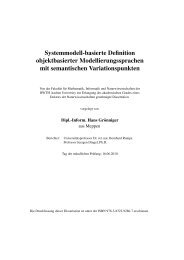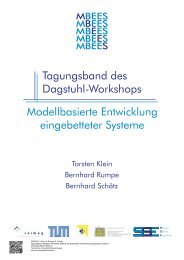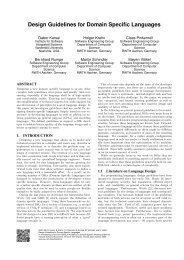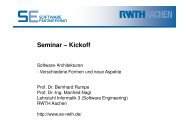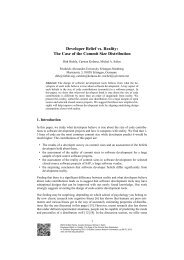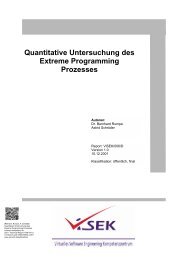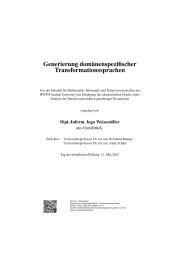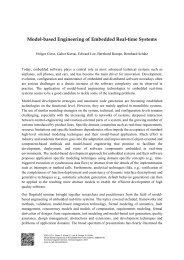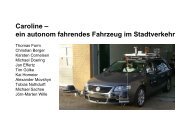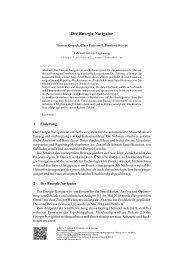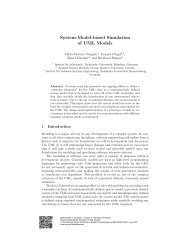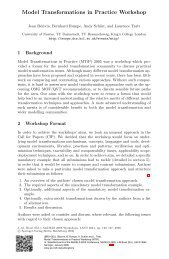Semantic Differencing for Activity Diagrams - Software Engineering
Semantic Differencing for Activity Diagrams - Software Engineering
Semantic Differencing for Activity Diagrams - Software Engineering
You also want an ePaper? Increase the reach of your titles
YUMPU automatically turns print PDFs into web optimized ePapers that Google loves.
Figure 4: The prototype plug-in, comparing two ADs, hire.v2 and hire.v4. The highlighted and numbered<br />
nodes show one of the two diff traces found by addiff : <strong>for</strong> an internal employee, the trace register, get<br />
welcome pack, and assign to project is possible in hire.v2 and is not possible in hire.v4. A detailed textual<br />
representation of this diff trace is provided in the lower pane.<br />
(reachable) state space, the number of diff traces found, the<br />
length of the shortest and longest diff traces found, and the<br />
times it took the concrete and the symbolic algorithms to<br />
(1) decide the existence of at least one diff trace and (2) to<br />
compute all diff traces.<br />
To examine scalability, we used synthetic ADs of comparable<br />
or much larger size (in both number of action nodes<br />
and state space), divided into two families of ‘worst case’<br />
ADs: a family of ‘<strong>for</strong>king ADs’ with concurrent section of<br />
length L and growing width W , and a family of ‘linear ADs’<br />
with two linear fragments of length L seperated by a single<br />
decision over a domain of increasing size D. The lower part<br />
of Table 1 shows results from executing addiff on these ADs,<br />
with versions created using synthetic mutations: replacing,<br />
deleting, or moving of actions.<br />
These results suggest the following observations. First,<br />
on small ADs, the two algorithms show similar per<strong>for</strong>mance<br />
results. However, as the ADs grow, the symbolic algorithm<br />
per<strong>for</strong>ms much better than the concrete one. On the largest<br />
ADs, the concrete algorithm per<strong>for</strong>mance is not practical<br />
while the symbolic algorithm stays within less than 4 seconds<br />
(on all real-world ADs). We believe this means addiff can<br />
be used by engineers in practice.<br />
Second, checking <strong>for</strong> the existence of a difference is sometimes<br />
much faster than listing all diff traces, specifically<br />
when there are many diff traces or when the shortest one<br />
is much shorter than the longest one. Again, as the ADs<br />
grow, the symbolic algorithm outper<strong>for</strong>ms the concrete one.<br />
That said, we do have synthetic ‘worst case’ examples<br />
where the symbolic algorithm is not better than the concrete<br />
one. This happens, e.g., in the extreme case of a long linear<br />
AD with no branches or <strong>for</strong>ks. It also happens when the<br />
number of diff traces is large and enumerating them takes<br />
much time. Moreover, the specific change done between the<br />
two ADs may have significant effect on both algorithms’<br />
per<strong>for</strong>mance: two very syntactically similar mutations (e.g.,<br />
a rename in one branch or in another), may induce dramatic<br />
changes in the number of diff traces. Complete results of and<br />
models used in our experiments are available from [28].<br />
6.1.2 Qualitative evaluation<br />
As mentioned above, we have obtained several real-world<br />
ADs with version history in<strong>for</strong>mation from Nokia Corp.,<br />
Test Management, and from another company. We used<br />
our plug-in to compare different versions and analyze the<br />
evolution of these ADs. We have also used other publicly<br />
available diff tools (Eclipse default differencing mechanism<br />
and EMFCompare [5]) in the analysis and compared them<br />
with addiff . Screen captures from our analysis sessions are<br />
available from [28].<br />
Classical textual differencing was, as expected, not helpful<br />
in comparing the ADs, as it merely compared their XMI<br />
representations. EMFCompare [5] reported correct addition<br />
and removal of actions and transitions and presented them<br />
on the abstract syntax tree structures of the two ADs. Still,<br />
this was not so helpful in understanding the differences between<br />
the ADs because (1) the comparison was done on<br />
the AST level and abstracted the control flow away, and<br />
(2) the results were shown on the AST and not on the<br />
ADs themselves: we saw the changes in the AST and had<br />
to manually search <strong>for</strong> their concrete manifestation on the<br />
ADs. Moreover, in many cases, the list of additions and<br />
removals reported by EMFCompare was too large to be useful,<br />
e.g., when comparing hire.v2 and hire.v4 (presented<br />
earlier), EMFCompare reported 23 additions and removals,<br />
much more than one would intuitively expect <strong>for</strong> these two



